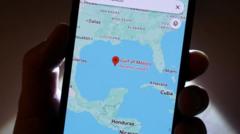In a bold move, Mexican President Claudia Sheinbaum has reached out to tech giant Google, urging them to rethink their decision to re-label the Gulf of Mexico as the Gulf of America. This controversial shift stems from an executive order by former US President Donald Trump issued in the early days of his administration, mandating the name change for US maps.
However, Google Maps intends to implement the name change exclusively for users within the United States, while the rest of the globe will continue to recognize the historic designation "Gulf of Mexico." Sheinbaum argues that the United States lacks legal authority to alter the name of the Gulf, as outlined by the United Nations Convention on the Law of the Sea, which stipulates that a country's sovereignty extends only 12 nautical miles from its coast.
Sheinbaum emphasized, "[The name change] could only correspond to the 12 nautical miles away from the coastlines of the United States of America." This request comes amidst an absence of any international regulatory body responsible for naming maritime zones, giving rise to further contention on the matter.
In response to a BBC inquiry, Google has maintained its policy of reflecting official government name changes, stating: "We have a longstanding practice of applying name changes when they have been updated in official government sources." The tech company also mentioned that discrepancies among international names would lead users to see the local official names on the map.
Furthermore, President Sheinbaum expressed her discontent with humanitarian implications of Google's decision, arguing that it should not heed the dictates of a singular nation regarding the nomenclature of an international water body. Displaying a sense of humor associated with the ongoing political climate, she quipped about asking Google to adjust more geographical names, such as changing North America to "América Mexicana."
As the discourse around the name change continues, the significance of preserving historical landmarks and names while navigating international relations comes to the forefront in an era where environmental and cultural legacies are closely interwoven.
However, Google Maps intends to implement the name change exclusively for users within the United States, while the rest of the globe will continue to recognize the historic designation "Gulf of Mexico." Sheinbaum argues that the United States lacks legal authority to alter the name of the Gulf, as outlined by the United Nations Convention on the Law of the Sea, which stipulates that a country's sovereignty extends only 12 nautical miles from its coast.
Sheinbaum emphasized, "[The name change] could only correspond to the 12 nautical miles away from the coastlines of the United States of America." This request comes amidst an absence of any international regulatory body responsible for naming maritime zones, giving rise to further contention on the matter.
In response to a BBC inquiry, Google has maintained its policy of reflecting official government name changes, stating: "We have a longstanding practice of applying name changes when they have been updated in official government sources." The tech company also mentioned that discrepancies among international names would lead users to see the local official names on the map.
Furthermore, President Sheinbaum expressed her discontent with humanitarian implications of Google's decision, arguing that it should not heed the dictates of a singular nation regarding the nomenclature of an international water body. Displaying a sense of humor associated with the ongoing political climate, she quipped about asking Google to adjust more geographical names, such as changing North America to "América Mexicana."
As the discourse around the name change continues, the significance of preserving historical landmarks and names while navigating international relations comes to the forefront in an era where environmental and cultural legacies are closely interwoven.






















